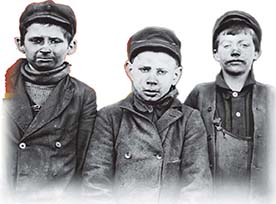SECTION 1: The Drive for Reform

▲ These boys toiled in a West Virginia coal mine.
WITNESS HISTORY  AUDIO
AUDIO
Children in the Coal Mines
Progressive reformers were appalled by the child labor that was common in coal mines, textile mills, and other industries. John Spargo, a union organizer and socialist, sadly described the terrible conditions endured by boys working in the coal mines.
“The coal is hard, and accidents to the hands, such as cut, broken, or crushed fingers, are common among the boys. Sometimes there is a worse accident: a terrified shriek is heard, and a boy is mangled and torn in the machinery, or disappears in the chute to be picked out later smothered and dead. Clouds of dust fill the breakers and are inhaled by the boys, laying the foundations for asthma and miners’ consumption.”
—John Spargo, The Bitter Cry of the Children, 1906
Objectives
- Identify the causes of Progressivism and compare it to Populism.
- Analyze the role that journalists played in the Progressive Movement.
- Evaluate some of the social reforms that Progressives tackled.
- Explain what Progressives hoped to achieve through political reforms.
Terms and People
- Progressivism
- muckraker
- Lincoln Steffens
- Jacob Riis
- Social Gospel
- settlement house
- Jane Addams
- direct primary
- initiative
- referendum
- recall
NoteTaking
Reading Skill: Identify Details Fill in a chart like this one with details about Progressivism.
Why It Matters Industrialization, urbanization, and immigration brought many benefits to America, but they also produced challenging social problems. In response, a movement called Progressivism emerged in the 1890s. Progressives believed that new ideas and honest, efficient government could bring about social justice. Progressive ideas brought lasting reforms that still affect society today. Section Focus Question: What areas did Progressives think were in need of the greatest reform?
Origins of Progressivism
The people who made up the Progressive Movement came from many walks of life. They came from all political parties, social classes, ethnic groups, and religions. Many Progressive leaders emerged from the growing middle class, whose power and influence was rapidly spreading. Dissatisfied industrial workers also joined the Progressive Movement. So did a few wealthy Americans driven by a desire to act for the good of society.
Progressives Share Common Beliefs
What the Progressives shared in common was a belief that industrialization and urbanization had created troubling social and political problems. Progressives wanted to bring about reforms that would correct these problems and injustices. They encouraged their state legislatures and the federal government to enact laws to address the issues faced by the poor. Progressives wanted to use logic and reason to make society work in a more efficient and orderly way. Many, motivated by religious faith, sought social justice.





